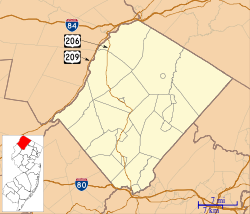Minisink Archeological Site | |
 South bank of Raymondskill Creek near confluence with Delaware River. The bank is eroding into the Manna archeological site. | |
| Nearest city | Bushkill, Pennsylvania and Millbrook, New Jersey |
|---|---|
| Area | 1,320 acres (530 ha) |
| NRHP reference No. | 93000608 [1] |
| Significant dates | |
| Added to NRHP | April 19, 1993 [1] |
| Designated NHL | April 19, 1993 [2] |
Minisink Archeological Site, also known as Minisink Historic District, is an archeological site of 1320 acres located in both Sussex County, New Jersey and Pike County, Pennsylvania. [3] It was part of a region occupied by Munsee-speaking Lenape that extended from southern New York across northern New Jersey to northeastern Pennsylvania. The Munsee were speakers of one of the three major language dialects of the Lenape Native American tribe. This interstate territory became the most important Munsee community for the majority of the 17th and 18th centuries. [2]



